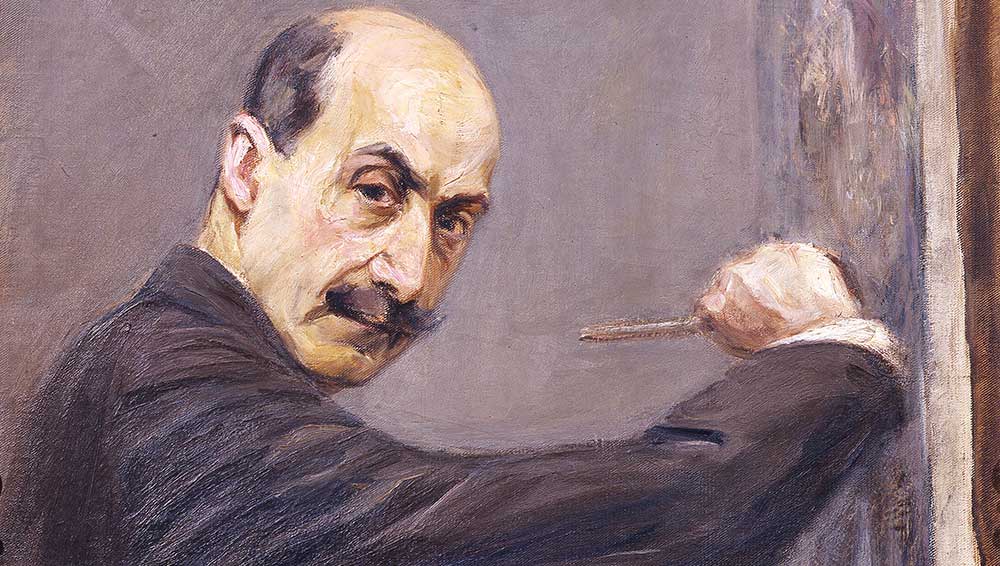
Max Liebermann, Self-portrait at the easel to the right, 1908 (detail). Oil on canvas. Gallerie degli Uffizi, Florence © Gabinetto Fotografico delle Gallerie degli Uffizi.
Liebermann-Villa am Wannsee, Berlin
4 May – 2 September 2024
by SABINE SCHERECK
Holland’s coast is where the German impressionist painter Max Liebermann (1847-1935) enjoyed many blissful summer holidays and felt much at home. A substantial part of his work features the North Sea and the flat, windswept landscape with its rural folk. Italy is usually only a footnote in his biography, but now, for the first time, the Liebermann-Villa in Berlin treads a path no one has taken before by tracing his visits to Italy in the exhibition To Italy! With Liebermann in Venice, Florence and Rome. Liebermann was 31 when he first went to Venice in 1878. What prompted him to go there in the first place? Or what had stopped him from going earlier?
After all, before Paris had become the centre of the art world at the turn of the 20th century –attracting artists from all over Europe and America seeking training, inspiration and public praise, including Liebermann himself – artists had their eyes set on Italy to hone their craft by studying the masters of the Renaissance and the antiquity. In the 18th and 19th century, the Grand Tour was fashionable with Britons of the privileged classes. In France, the Académie Française had offered scholarships to their artists to explore Italy. The painters Edgar Degas, JMW Turner and Angelika Kauffmann, the art historian Johann Joachim Winckelmann and the architect Karl Friedrich Schinkel all headed south. In Germany especially, Johann Wolfgang von Goethe’s writings about his journey to Italy in 1786 had a strong cultural impact.
.jpg)
To Italy! With Liebermann in Venice, Florence and Rome, installation view. Max Liebermann Society Berlin. Photo: Thomas Lingens.
For a respected artist and admirer of Goethe such as Liebermann, one would assume Italy would have been top of his list of places to go, but it was not. The Berlin-born artist, who had a hard time finding recognition as an artist in Germany and in 1870s Paris, hesitated. He was too much in awe of Italy, but after disappointments in Paris he was looking for a new direction. Italy was a wise choice: he made links to local artists, returned several times until 1913, took part in exhibitions and was not only represented in the 1st Venice Biennale in 1895 and, as a renowned German artist, belonged to the international patronage committee, he even was awarded the international prize of the Province of Venice for his pastel portrait of the German dramatist Gerhart Hauptmann.
Following the 2nd Biennale, his work Brabant Women Making Lace (1893-94) entered the collection of the Galleria Internazionale d’Arte Moderna. He left such an impression in Italy that the director of the Uffizi Galleries in Florence commissioned a self-portrait of him for the museum in 1908, which is part of its collection to this day and can now be admired as a loan here. It is, in fact, a self-portrait unlike the others he produced. Here, you can see him holding the paintbrush in his right hand, instead of his left. His look is concentrated on the viewer while painting himself in front of an easel. For this, he used two mirrors to correct the image reflected by the first mirror. He went to great lengths to present the Uffizi with a truthful representation of himself.
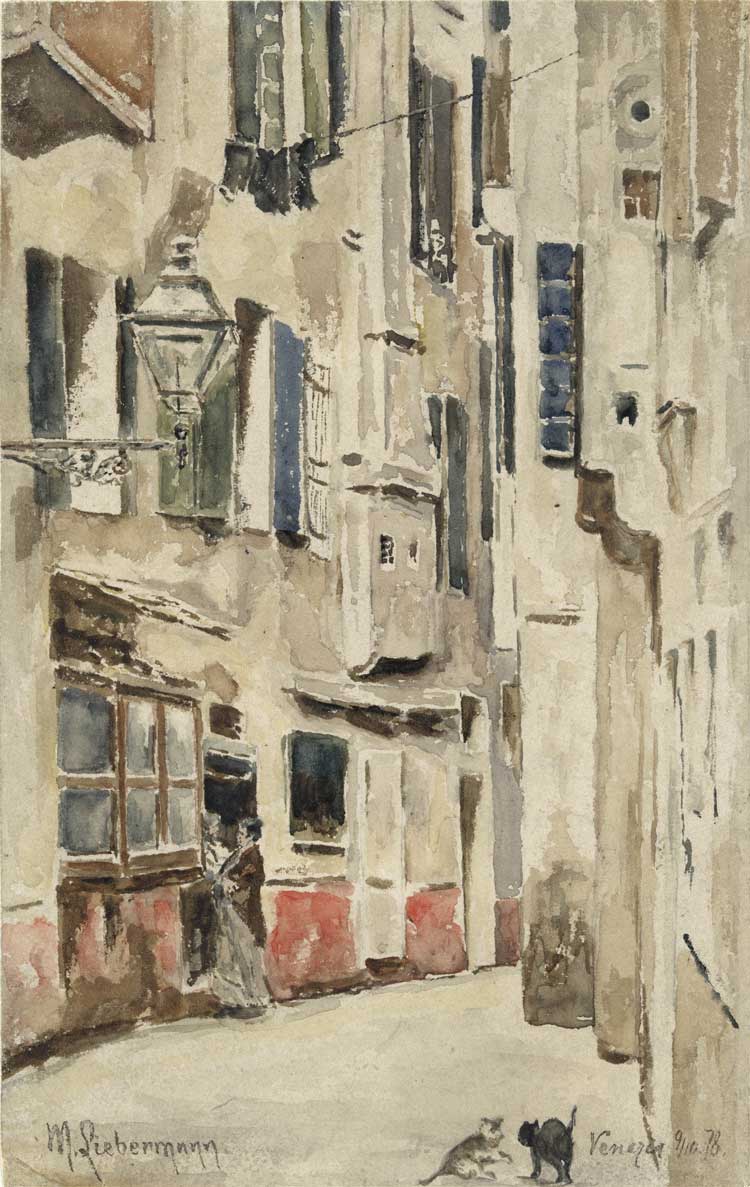
Max Liebermann, Alley in Venice, 1878. Watercolour on paper. Hamburger Kunsthalle © Hamburger Kunsthalle / bpk. Photo: Christoph Irrgang.
The exhibition follows Liebermann’s forays into Italy chronologically, starting with his first journey to Venice in the autumn of 1878. He stayed for two months and the scenes he cared about are gathered in his sketchbook. Having it here on display is fortunate as only 12 of the numerous sketchbooks he filled during his professional life are left. In this one are drawings of the everyday life of Tyrolese peasants and of the Venetian people – very much the same motifs he had captured in Holland. But there are also studies of the alleyways and facades of houses, which form the basis of street scenes later realised in oil paints and watercolours. Two examples are showcased here and to see the watercolour Alley in Venice (1878) next to the oil painting Venetian Alley to the Right (1878) is intriguing. The version in oil paint is slightly darker and has a less summery feel. The book also contains a sketch of the inside of the Sephardic synagogue Scuola Levantina in the Jewish ghetto in Venice. As Liebermann was Jewish, it seems natural that he would have visited that part of town. He returned several times to Venice and although not personally present at the 1922 biennale, 23 of his works filled a dedicated hall in the German pavilion.
.jpg)
Exhibition wall showing the cities Max Liebermann visited in Italy. Max Liebermann Society Berlin. Photo: Thomas Lingens.
His journey to Venice did give him a new direction. He met fellow German artist Franz von Lenbach there, who recommended going to Munich afterwards, which he did. Fifteen years passed until Liebermann returned to Italy. This time the journey took him to Florence in spring 1893. He was accompanied by his wife and seven-year-old daughter. As in Venice, he was not drawn to the sights of the city or its hustle and bustle, but sought out the quieter places. His impressions of Florence made him think more favourably of Italy than before and a return to the city nine years later, in 1902, produced the much-admired landscape pastel Monte Oliveto Florence (1902), showing a sumptuous green hill rising behind the sandstone coloured houses and red roofs of the city. In the distance, on top of the hill is the church of San Bartolomeo lined by typical Tuscan trees.
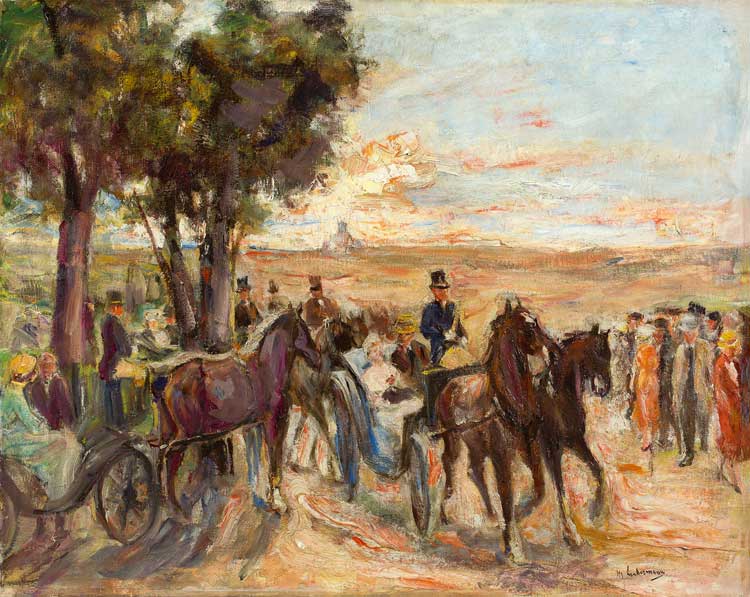
Max Liebermann. Corso on the Monte Pincio in Rome, 1930–32. Oil on canvas. Private collection © Grisebach GmbH.
In October that year, Liebermann headed to Rome for the first time, “to at least have seen it”, he said; he stayed for only two weeks. A scene that he captured right there and then in his sketchbook was Pope Leo XIII receiving an ecstatic group of pilgrims, which Liebermann later turned into an oil painting, which is also part of the exhibition. The second journey that brought him to Rome in 1911 was his participation in the Esposizione Internazionale di Roma. During this sojourn he sketched the Roman promenade at the park of Monte Pincio, which found its way in different versions into several oil paintings. Naples was Liebermann’s last destination when visiting Italy in 1913, the outbreak of the first world war putting an end to his journeys abroad. Instead, he spent his summers in his villa at Lake Wannsee, which hosts this exhibition. Also his age – he was over 70 by then – made travelling difficult.
Although the exhibition focuses on Liebermann’s visits to the three major Italian cities, he travelled much more widely through the country, including Siena, Pisa, Genoa, Milan, Bellagio, Bergamo, Verona and Perugia. A map with historic views of these cities very nicely illustrates that. Equally fascinating is the timeline tracing the exhibitions in Italy showing his works: Venice, twice (1895 and 1922), Florence (1896), Rome three times (1902, 1911 and 1923) and Milan (1924). This is wonderfully presented through posters of the exhibitions, which give a feel for the period.
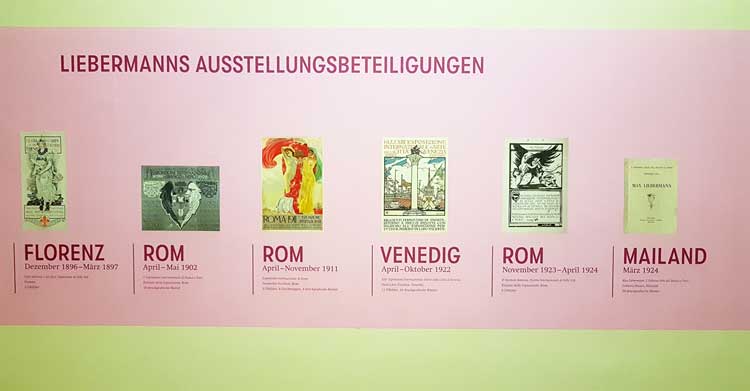
Exhibition wall showing the Italian exhibitions that Max Liebermann participated in. Photo: Sabine Schereck.
The show is complemented by the portrayal of three Italian men Liebermann met: The Trieste painter Umberto Veruda (1868-1904), the Milanese art critic Guido Lodovico Luzzatto (1903-91) and, most importantly, the Naples-born art critic Vittorio Pica (1862-1930), who was the general secretary of the Biennale in Venice and championed Liebermann in his art periodical Emporium. In the 1920s, Pica twice visited the Liebermanns in Berlin.
Besides the works Liebermann produced in Italy, did the Mediterranean experience leave an imprint on his work? The subject matter in his works are close to those he had depicted before. Apart from a few exceptions, the viewer would not necessarily spot that the scenes were set in Italy. The colour palette also remains more or less the same, as does his style. Unlike other colleagues, he did not go to Italy to study its art, but to educate himself culturally, bearing in mind that he usually travelled with his wife and daughter.
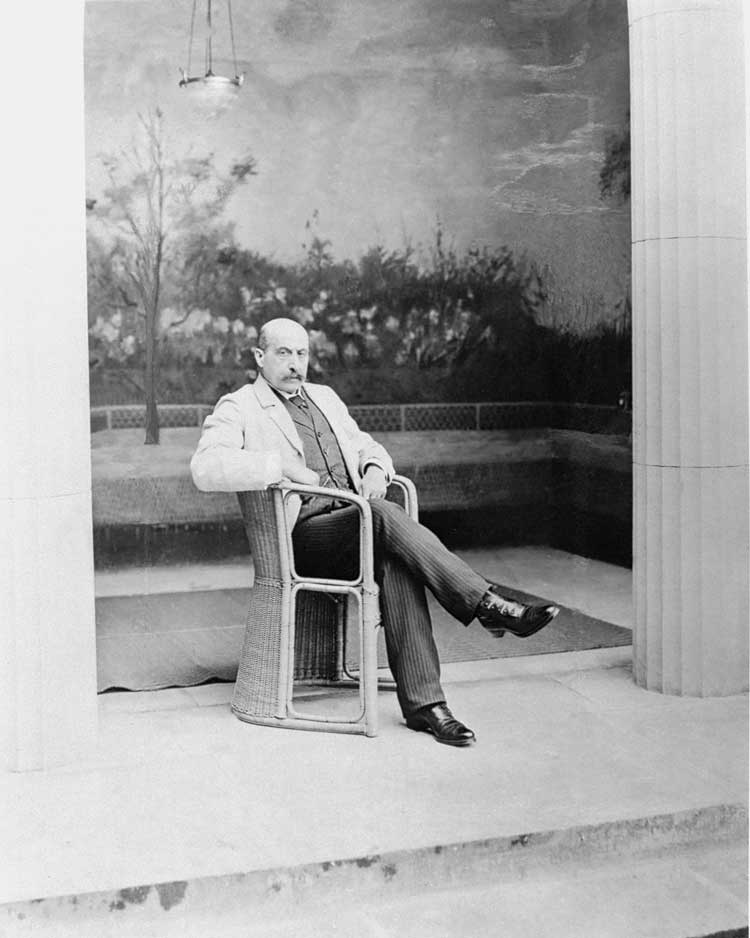
Max Liebermann in front of the loggia, 1914. Max Liebermann Society Berlin.
Despite all this, there is one thing of Italian flair that Liebermann cared to bring to Berlin. Inspired by his visit to the Villa of Livia, north of Rome, where an old fresco conjured up an idyllic garden with pomegranate trees, flowers and birds, Liebermann decided to create his own version of it by covering the walls of the outside loggia of his newly built villa on the banks of lake Wannsee with a garden scene. Unfortunately, only a few traces of colour are left at the original site, but a black-and-white photo of Liebermann sitting leisurely in front of it, gives an idea of what it looked like.
The curator, Alice Cazzola, has done a sterling job unearthing the material relating to Liebermann’s connections to Italy and presenting the surprising discovery of how well his works were received there.
• This exhibition will be shown in an adapted version, under the title Max Liebermann – An Impressionist from Berlin, at the Casa di Goethe in Rome, from 19 September 2024 to 9 February 2025.